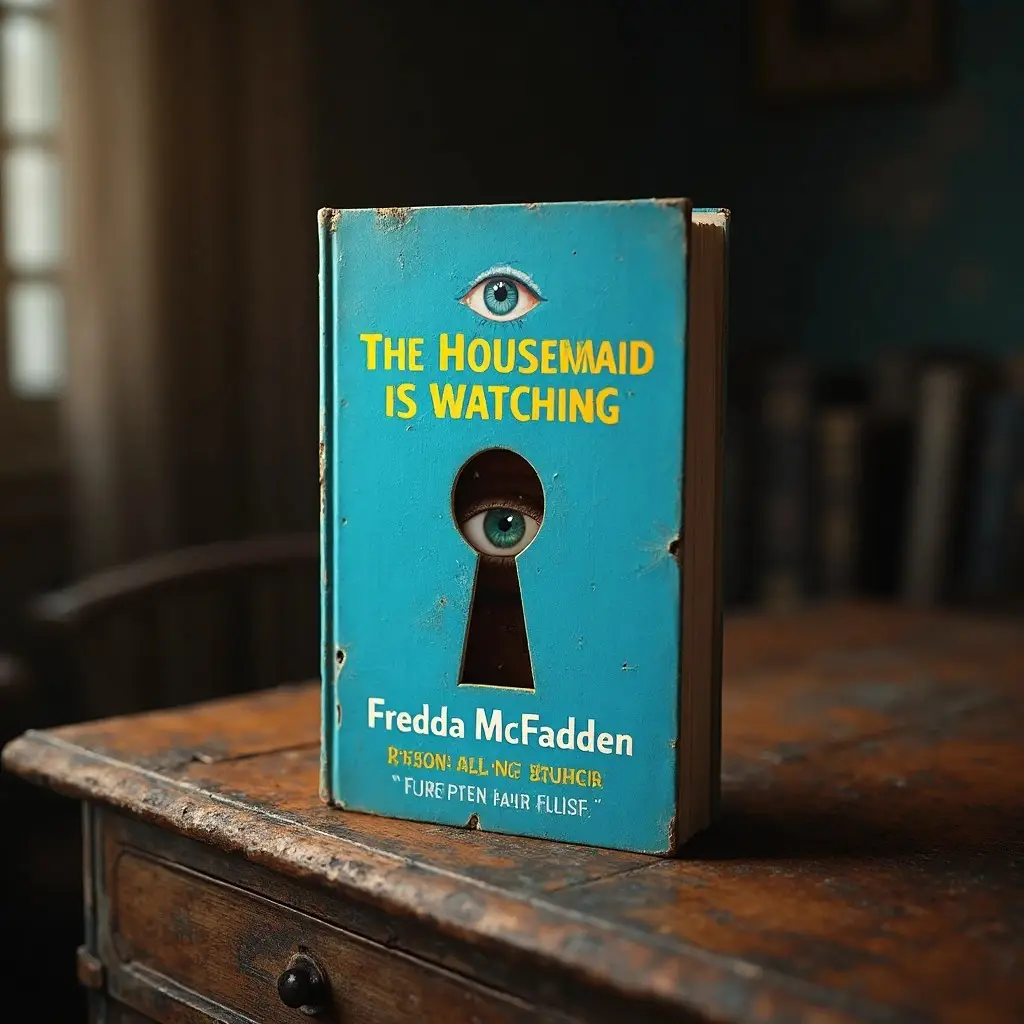Last updated on June 6th, 2025 at 09:30 pm
The Housemaid Is Delighted by Freida McFadden marks the third gripping installment in McFadden’s bestselling psychological thriller series. This domestic suspense novel follows former housemaid Millie, now a social worker living in suburbia with husband Enzo and their two children. The thriller features Millie as she becomes suspicious of her peculiar neighbors and their unsettling housemaid on a seemingly quiet cul-de-sac.
I picked up this book after devouring McFadden’s previous works, drawn by her reputation as a #1 New York Times bestselling author who masterfully blends medical expertise with psychological suspense. What makes this series stand out is how McFadden, a practicing physician specializing in brain injury, weaves authentic psychological elements into suburban settings that feel disturbingly familiar.
McFadden’s strength lies in her unpredictable plot twists that subvert reader expectations, though some may find the pacing occasionally uneven in the middle chapters. The book tackles themes of trust, paranoia, and the masks people wear in polite society. What struck me most was how the author explores the concept of watching versus being watched, creating layers of surveillance that mirror our social media-obsessed culture.
This thriller left me second-guessing every friendly neighbor interaction, proving McFadden’s continued mastery of domestic psychological suspense that will appeal to fans of Ruth Ware and Lisa Jewell.
Key Takeaways
- Character evolution shines as Millie transforms from vulnerable housemaid to protective mother and social worker, showcasing one of the most compelling character arcs in contemporary psychological thrillers
- Suburban gothic atmosphere effectively transforms an ordinary Long Island cul-de-sac into a psychological pressure cooker where neighborly facades hide dark secrets and surveillance
- Pacing issues emerge in middle chapters compared to previous installments, though McFadden’s signature slow-burn technique still builds tension effectively toward shocking revelations
- Complex themes explored include generational trauma, the masks people wear in polite society, and how past experiences shape present paranoia in domestic settings
- Family dynamics add depth as the Accardi family’s suburban dream becomes complicated by Millie’s hypervigilant protective instincts and the strain of maintaining normalcy
- Series fans will appreciate the continued evolution of McFadden’s domestic suspense mastery, though newcomers should start with earlier books for full character context
Publishing Information: June 13, 2023 by Bookouture
Genre: Psychological Thriller, Domestic Suspense
Series Information: Book 3 in The Housemaid series
Page Count: 348 pages
Main Characters:
- Millie Calloway: The housemaid and central protagonist, whose past secrets threaten her new life.
- Enzo Calloway: Millie’s husband, trying to protect his family.
- Daisy Calloway: Millie and Enzo’s young daughter.
- Douglas Garrick: Millie’s former employer, whose presence looms over the story.
- Wendy: Millie’s new neighbor, whose behavior raises suspicions.
- Mrs. Lowell: Another neighbor, adding to the tension and intrigue.
- Detective Ramirez: Investigates the events that unfold in Millie’s neighborhood
Series Context And Synopsis
The third installment in this psychological thriller series marks a significant evolution in both character development and narrative scope. After eleven years, readers witness a transformed Millie who has successfully rebuilt her life from the shadows of her troubled past.
From Housemaid To Homeowner: Millie’s Trip Through The Trilogy
Millie’s transformation from desperate housemaid to settled social worker represents one of the most interesting character arcs I’ve encountered in recent thriller series. Her marriage to landscaper Enzo Accardi and their two children—daughter Ada and son Nicholas—showcase how far she’s traveled from her dark beginnings. This evolution adds emotional weight to every threat that emerges in their new suburban paradise.
Behind Picket Fences: Plot Overview And New Setting
The family’s move to a quiet Long Island cul-de-sac with just two neighboring homes initially promises the American dream. However, Millie’s instincts quickly detect something unsettling about their overly curious neighbors and their mysterious housemaid.
The confined setting of three houses creates an intimate pressure cooker where secrets simmer beneath manicured lawns and friendly facades.
Psychological Suspense Elements
The psychological suspense in “The Housemaid Is Watching” operates on multiple levels that kept me turning pages well past my intended bedtime. McFadden crafts tension through everyday suburban interactions that feel increasingly sinister with each encounter.
Suburban Gothic: The Darkness Beneath Domestic Tranquility
McFadden transforms the quintessential American cul-de-sac into a psychological minefield where manicured lawns hide buried secrets. The three-house setting becomes a pressure cooker where neighborly pleasantries mask surveillance and suspicion. Each perfectly maintained facade conceals brewing darkness that slowly seeps through carefully constructed social barriers.
Paranoia And Perception: Unreliable Narration Techniques
Millie’s narration brilliantly blurs the line between legitimate concern and psychological challenges as she questions every neighbor’s motive. McFadden plants seeds of doubt about Millie’s perceptions while simultaneously validating her fears through subtle environmental clues. The narrative technique makes readers constantly recalibrate their trust in the protagonist’s increasingly frantic observations.
Character Evolution And Dynamics
The most striking aspect of “The Housemaid Is Watching” lies in how dramatically Millie has evolved since her desperate housemaid days. Her character arc represents one of the most interesting transformations I’ve encountered in contemporary psychological thrillers.
Millie’s Transformation: From Cleaner To Protector
Millie’s evolution from vulnerable cleaner to fierce family protector creates the emotional backbone of this third installment. Her past experiences now serve as armor rather than shame, informing her instincts about danger in suburban disguise.
| Character Evolution Elements | Previous Books | “The Housemaid Is Watching” |
|---|---|---|
| Primary Role | Domestic worker/survivor | Social worker/mother |
| Vulnerability Level | High (isolated, desperate) | Medium (family support system) |
| Protective Instincts | Self-preservation focused | Family-centered protection |
| Trust Issues | Severe mistrust of employers | Selective skepticism of neighbors |
| Problem-solving Approach | Reactive survival tactics | Proactive investigation methods |
The shift from reactive survival to proactive protection marks Millie’s most significant character development. Where she once endured mistreatment and manipulation, she now actively investigates threats before they materialize. Her social work background provides professional insight into human behavior that her previous domestic roles never offered.
Millie’s protective instincts now extend beyond self-preservation to encompass her entire family unit. This expansion of her emotional investment raises the stakes considerably – she’s no longer just fighting for her own survival but defending the life she’s built with Enzo and their children.

Family Under Pressure: The Accardi Family’s Trials
The Accardi family dynamics create a pressure cooker atmosphere that tests every relationship within the household. Enzo’s unwavering support contrasts sharply with the children’s varying levels of awareness about their mother’s increasingly paranoid behavior regarding their neighbors.
| Family Pressure Points | Impact on Character Development |
|---|---|
| Financial stress from new mortgage | Forces practical decision-making |
| Children’s adjustment to new neighborhood | Creates parental protection anxiety |
| Marital strain from Millie’s suspicions | Tests relationship foundation |
| Extended family absence | Increases isolation and vulnerability |
Ada and Nicholas (Nico) serve as both motivation and vulnerability for Millie’s protective instincts. Their innocent interactions with neighborhood children become sources of maternal anxiety rather than normal childhood socialization. The children’s perspectives remain largely sheltered from the adult tensions, creating an interesting dynamic where their normalcy contrasts with their mother’s hypervigilance.
Enzo’s role as the stable anchor becomes increasingly important as Millie’s investigations intensify. His landscaping work provides him with different neighborhood insights than Millie’s social worker perspective, creating interesting conflicts about how to interpret their neighbors’ behavior. The eleven-year marriage foundation proves important when external pressures threaten to destabilize their family unit.
The suburban setting amplifies family pressures in unexpected ways. The cul-de-sac’s intimate geography means privacy becomes nearly impossible, forcing the Accardis to find your way their personal struggles under constant potential observation.
This environmental pressure transforms ordinary family discussions into strategic conversations about maintaining appearances while protecting their children from both real and perceived threats.
Narrative Structure And Pacing
McFadden’s third installment follows a especially different structural approach compared to its predecessors. The narrative primarily centers on Millie’s perspective as she navigates suburban family life rather than the claustrophobic employer-employee dynamics that defined earlier books.
Dual Perspectives: Adult Fear And Childhood Innocence
The book creates an interesting contrast between Millie’s hypervigilant paranoia and her children’s blissful unawareness of potential neighborhood dangers. Ada and Nicholas represent untainted suburban childhood while Millie sees threats lurking behind every manicured lawn and friendly wave.
Tension Building: From Slow-Burn To Shocking Revelation
McFadden employs her signature slow-burn technique, but some readers found the pacing rushed compared to previous entries. The revelations feel less impactful than expected, though the epilogue delivers an unexpected twist that caught many off guard even though predictable main plot elements.
Thematic Exploration
McFadden weaves complex psychological threads throughout this suburban thriller that dig deeper than surface-level neighborhood drama. The novel operates on multiple thematic layers that examine how past trauma shapes present behavior and how community facades mask darker truths.
Facades And Family Secrets: What Lies Beneath
The pristine suburban setting becomes a character itself in exploring deception beneath normalcy. McFadden masterfully contrasts manicured lawns with buried secrets, showing how neighborhood pleasantries often mask surveillance and suspicion.
Each household in the cul-de-sac presents a carefully constructed image while harboring significant secrets. The Lowells’ perfect marriage crumbles under infidelity, while their housemaid’s behavior grows increasingly disturbing and unpredictable.
Millie’s own family struggles with maintaining appearances while dealing with her hypervigilant behavior. Her past as a former convict creates additional pressure to appear “normal” to avoid scrutiny from neighbors and authorities.
Generational Conflict: The Cycle Of Protection And Trauma
The novel subtly explores how trauma echoes through generations, particularly through Millie’s fierce protective instincts toward her children. Her criminal past informs her ability to recognize danger, but also threatens to perpetuate cycles of conflict.
McFadden examines how parents’ attempts to shield children from harm can sometimes create new forms of psychological damage. Millie’s hypervigilance about neighborhood threats affects her children’s sense of security and normalcy.
The author raises questions about whether survival instincts learned through trauma become liabilities in peaceful settings. Millie’s past experiences serve as both armor and burden as she navigates suburban motherhood.

Comparative Analysis
I’d place this third installment somewhere in the middle of McFadden’s series in terms of overall impact. While it doesn’t quite reach the shocking heights of the original “The Housemaid” it definitely surpasses some of the weaker entries I’ve encountered in similar thriller series.
What sets this book apart is how it evolves beyond the typical employer-employee dynamic that defines most domestic thrillers. McFadden’s decision to shift Millie into a completely different role shows real growth as a storyteller.
The suburban setting works brilliantly as a backdrop for psychological tension even if some plot elements feel familiar. I appreciate how the author doesn’t rely solely on twists to carry the narrative but instead builds genuine character development that makes you invested in the outcome.
If you’re new to McFadden’s work I’d still recommend starting with the first book. But for existing fans this delivers enough fresh perspective and solid suspense to justify the read.
Final Verdict
I was genuinely moved by Millie’s transformation from desperate housemaid to fierce protective mother – McFadden’s strongest character development yet. I loved how the suburban gothic atmosphere turned ordinary neighborly interactions into psychological warfare.
However, I struggled with uneven pacing in middle chapters, and I predicted several twists compared to earlier installments’ shocking reveals. The cul-de-sac setting gave me perfect claustrophobic tension, but rushed revelations disappointed my sky-high expectations. I’d recommend it for series fans, though newcomers should start elsewhere.
Dionysus Reviews Rating: 6.5/10
Sip The Unknown—Discover Stories You Never Knew You’d Love!
Dionysus Reviews Has A Book For Every Mood
Biography & Memoir
Fiction
Mystery & Detective
Nonfiction
Philosophy
Psychology
Romance
Science Fiction & Fantasy
Teens & Young Adult
Thriller & Suspense
Frequently Asked Questions
Is “The Housemaid Is Delighted” the third book in the series?
Yes, “The Housemaid Is Delighted” is the third installment in Freida McFadden’s bestselling psychological thriller series. It continues Millie’s story, showing her evolution from a desperate housemaid in the earlier books to a settled social worker and mother living in a suburban Long Island cul-de-sac.
Do I need to read the previous books to understand this one?
While “The Housemaid Is Delighted” can be read as a standalone, reading the previous books will give you a much deeper understanding of Millie’s character development and traumatic past. Her transformation from vulnerable cleaner to fierce family protector is more meaningful when you know her backstory.
What is Millie’s role in this third book?
In this installment, Millie has evolved significantly from her previous circumstances. She’s now a social worker, married to Enzo Accardi, and mother to two children, Ada and Nicholas. She’s settled into suburban family life but becomes increasingly suspicious of her unusual neighbors and their disturbing housemaid.
What makes this book different from the previous ones?
The narrative structure shifts to focus primarily on Millie’s perspective as she navigates suburban family life, contrasting with the claustrophobic employer-employee dynamics of earlier books. The setting moves from domestic servitude scenarios to neighborhood drama in a quiet cul-de-sac environment.
Is the pacing consistent with previous books in the series?
Some readers found the pacing uneven compared to previous entries, with certain revelations feeling rushed and less impactful than McFadden’s earlier work. However, the author still employs her signature slow-burn technique, and the epilogue delivers an unexpected twist that surprises many readers.
What themes does the book explore?
The novel explores themes of trust, paranoia, societal facades, and how past trauma shapes present behavior. It examines generational conflict, community deception beneath suburban normalcy, and whether survival instincts learned through trauma become liabilities in peaceful settings.
How does Millie’s character development compare to earlier books?
Millie shows dramatic growth from a reactive survivor to a proactive protector. Her past experiences now serve as both armor and burden, informing her danger instincts while potentially threatening to perpetuate cycles of conflict. She’s transformed from enduring mistreatment to actively investigating threats to her family.
What role does the suburban setting play in the story?
The Long Island cul-de-sac becomes a psychological complex situation where manicured lawns hide secrets and neighborly pleasantries mask surveillance. The intimate geography makes privacy impossible, creating a pressure cooker atmosphere where ordinary family discussions become strategic conversations about maintaining appearances.
Are there any content warnings for this book?
The book contains psychological suspense and thriller elements typical of the genre. While not explicitly detailed in available information, given the series’ nature and themes involving past trauma, domestic situations, and psychological tension, readers sensitive to these topics should approach with awareness.









